Daleem is a small terrestrial planet in the Nilgaard sector of the Outer Rim territories under the rule of the Vatali Empire.
History
Founding
Daleem was originally founded under the all-encompassing monarchy of Sephi civilization circa 657 BBY, concurrently with the founding of the system’s capital. Initially, it was settled by noble Lords that sought to exploit its natural resources, discovering vast caverns that allowed access to rare minerals buried deep beneath the bedrock. Over time, their subjects were brought to this new world to work the lives of merchants and laborers.
Naturally, the Lords’ subjects formed themselves into guilds, focusing their efforts on mining the caverns below the surface and the trade of foodstuffs and other necessities to the earliest settlements on neighboring worlds. The earliest guilds were formed with administrative needs in mind, maintaining the health of their workers and organizing labour throughout Daleem. The guilds have since grown as the Lords were no longer needed, beginning with the formation of the independent Shipwright's Guild that paved the route for others to seek political resources.
The planet was kept in a state of geological stability by a network of complex terraforming machines and stabilizers, which served to contain the mass of volcanic ranges which dotted the landmasses and suppress potential earthquakes. The machines themselves were constructed to be self-automated and serve their role with minimal oversight. Because of this, the work crews to help administer their operations were gradually scaled down over the course of several hundred years, until they were all but forgotten by the modern government.
Exiles' Arrival
Daleem would see a surprising change in 35 ABY, with the arrival of Clan Odan-Urr. The survivors of the New Tython atrocity had made their way to the Vatali Empire and eventually formed an alliance with the ruling Empress. In an effort to test the Clan’s claims of their abilities to retain peace and settle issues of diplomatic importance, House Satele Shan was granted access to Daleem. In return, the Jedi and their allies were charged with the task of settling disputes between the Guilds, and resolving conflicts that might hamper the development of important resources to the Vatali Empire. Granted the use of several kilometers of land surrounding a space elevator - which would become Sky Breach Base - House Satele Shan acted on behalf of the Empress to settle those issues which required mediation, or a third party to intervene. Led by Director Kasula Daegella and Executor Maximus Alvinius at this time, one of their initial crises emerged in the form of piracy. Shan was tasked with investigating a matter relating to the Shipwright’s Guild, with the disappearance of the Kesaret. One of several bulk freighters making runs between Daleem and Kiast, the Kesaret had been ferrying valuable cargo between the two worlds only for it to disappear without a trace. Because of their new role, Shan was required to investigate and resolve this matter before the situation escalated.
Known as the The Last Voyage of the Kesaret, the incident saw House Shan employing its resources alongside the Sentinel Network in its search for the missing vessel. This saw a number of members testing abilities that they themselves were not even aware of, and soon singled out the Maelstrom Corsairs as the group responsible for the abduction. Following a direct assault by the House, the Corsairs were driven back and their base of operations was destroyed. While the Corsairs were far from broken as a power, the event proved to be a morale boost to House Shan, giving them a much-needed victory in the wake of New Tython's loss.
The Guild Coup
Following the events of the Twelfth Great Jedi War and the rising threat of the anti-Force user crusade known as the Collective, Clan Odan-Urr's attention was diverted away from Daleem for some time. Upon House Shan's return after the battles which raged across Nancora, it became evident that the defeat of the Corsairs was far from an end to their threat. The War had sapped Shan of its military might and the House needed time to heal in the wake of the conflict. Instead, they were soon faced with a brand new conflict far closer to home than before. Intelligence gathered from the Corsairs' base of operations not only implicated members of the Brotherhood's Inquisition in backing the attack, but also indicated that the Shipwright's Guild itself was preparing to stage a coup against ruling the Vatali nobles. The Corsairs were merely a front, and a means to establish military might without risking suspicion. A massed assault by the Corsairs scattered what remained of Shan's military might, and left the survivors to regroup and be besieged within Sky Breach Base.
The House was barely given time to regroup before the Corsairs main fleet arrived, rapidly establishing orbital dominance over the world. As troops were deployed planetside by the invaders, Shan was left fighting to hold its ground and delay their victory. Despite being heavily outnumbered Tython Squadron launched its ships to combat the enemy fleet, seeking to run interference until a far more substantial counterattack could be made against their vessels. On the ground, similar actions were taken as a bloody firefight broke out across the Imperial Gardens, with Shan operatives seeking to deny their enemy the Vatali seat of power on Daleem. With most of their number still besieged inside Sky Breach Base by a far more substantial force, Shan found itself fighting a losing battle on every front. As the Corsairs deployed landing ships in a massed drop operation atop of the Foundry, the Guild's main headquarters, their victory seemed inevitable.
Yet just as the world was set to fall, a new arrival abruptly halted their advance. Dropping out of hyperspace, the Shan flagship, Remembrance of Seher directly engaged the enemy fleet. This distraction brought the Shan forces some much needed time to regroup even as the Corsair fleet surged to meet this new threat. This played directly into their enemies' hands. As the Corsairs moved with all speed, their flagship was left out of position and exposed without its escorts. From the other direction, the Resolve, a newly-acquired Vindicator-class Heavy Cruiser, ambushed and destroyed the Corsair flagship in a series of broadsides. Caught between the two far larger vessels and without a commanding group, the now leaderless Corsairs were left to be picked off and destroyed. Their fleet's destruction had a knock-on effect upon the ground forces below. Even inches from victory, upon learning that they were both now trapped and with reinforcements arriving to assist House Shan, their will to fight evaporated. Some tried to fight, others fled, but without coordination the momentum of their attack was broken. What had initially seemed like an inevitable victory soon became a rout as Shan's bedraggled defenders were reinforced from offworld, breaking the back of the Corsair military.
Dominion
In the wake of the conflict and attempted coup, House Shan was left to pick up the pieces. Daleem had been revealed not as a serene and controlled hub of the Vatali Empire, but a hotbed of secessionist activity and corruption. Because of this, even as the other guilds moved to occupy the power vacuum left by the Shipwright's Guild, Empress Kaltani delivered an edict to remove them from positions of authority. It stipulated that each would be required to relinquish their sovereignty, disband their private armies and accept an official garrison on the outskirts of their capital holding. JTF Satele Shan was given the task of keeping the peace during the transition, and providing security in a summit between the Empress' representative, Royal Guard Commander Slynn Keldra, and the guilds. The hope was that, even during their rebuilding, the firepower and capabilities of the JTF would be enough to subdue any thoughts of further rebellion.
During the summit, Seer Junazee detected unknown forces marshaling in the tunnels below and alerted the diplomatic mission in time for them to capture the heads of the remaining guilds and flee to Sky Breach Base. Corsair Haran 'Ji' Urr and a team of crack mercenaries investigated the tunnels and found that while the guilds were not directly tied to the pending assault on the summit, they were heavily implicated in a web of corruption and black market contracts that had flooded Kiast with scores of mercenary bands. For their efforts to secure Daleem for the Vatali Empire, both Satelites were tasked with overseeing the new garrisons and installed as barons over these new Imperial fiefs. Thus, Seer Junazee was granted the honorific of 'Baroness Sajin' and Corsair Haran that of 'Baron Zadan' corresponding to the guild capital cities their garrisons overlooked.
Scorched Earth

In late 37 ABY, Daleem underwent an unexpected crisis. The planet had been terraformed into its current state, but it required constant terraforming to support its ecosystem. While this technology was constantly defended and maintained for centuries, it was eventually forgotten by the ruling government following the death of its last chief mechanic. This lack of maintenance resulted in glitches emerging in the system, and the machine being thrown off by a single degree. Without warning or even fully understanding the threat posed against them, the planet faced a calamity unlike any other in its long existence. Volcanos simultaneously erupted across the world, and cities were rocked by near-perpetual earthquakes. The seas were flash boiled by kilotons of lava racing to the surface, resulting in explosive eruptions from the seabed. e. House Shan fought to maintain various rescue efforts during this crisis, and succeeded in enduring the cataclysm despite heavy collateral damage to the surrounding regions of the planet.
The End of an Era
In the months that followed, Clan Odan-Urr was given full citizenship within the Vatali Empire following the events of Operation: Vanguard, but this came at the cost of its existing structure. The Clan was required to streamline its membership and ranking system in order to carry out the tasks required of it, resulting in the dissolution of both House Hoth and House Shan. Each House's ships were gifted to the Vatali Navy, and in one final celebration on Palioxis Station House Satele Shan was disbanded entirely. In its place now stood House Sunrider.
With the aid of the Guilds’ tireless efforts, Daleem has since undergone extensive cooling since the loss of its terraforming apparatus. Stabilized against further significant changes to its outer crust, the periods of intense heating and cooling have resulted in the formation of massive crystalline sculptures, and a further widening of its tunnel networks to reveal structures resembling the architecture of the Velestari Temple on Kiast. Investing in the re-establishment of a thriving ecosystem, Daleems’ guilds have also begun efforts to import flora and fauna from other systems throughout the galaxy, marking the beginnings of a planet-wide reclamation project.
Geography
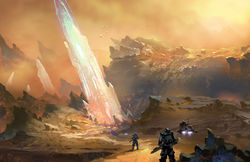
Daleem’s geology has undergone significant changes as a result of recent extensive volcanic activity and geological movement. Cracks and vents have formed in the upper crust, resulting in the emergence of geological features previously buried, including the massive crystalline structures once formed in the mantle. Also formed on the surface as a result of the rapid cooling of lava, these structures are varied in terms of mineral composition and can be seen protruding from the surface in sizes ranging from mountains to small deposits. In some areas, the superheating of sand has resulted in patches of a smooth, glass-like surface dotting the landscape.
By all accounts, it qualifies as showing potential as a paradise — both in vast quantities of resources and the prospect of once again being a habitable planet, with full, lush forests and self-sufficient colonies. However, given the loss of vast majorities of its flora and fauna in the cataclysmic event that preceded its transformation, Daleem is in a period of intensive and controlled reclamation by the guilds now charged with pursuing such efforts. In order to sustain its transformation into the promised paradise, it requires constant cultivation of its fertile soil in order to introduce an ecosystem that will one day be self-sufficient and thriving.
Oftentimes reflected in the crystalline formations in brilliant hues, the planet displays a full four-season cycle in its reclaimed landscape. Mountainous regions and barren deserts all occupy the surface, while dotted throughout the land are idyllic gardens and forests where reclamation efforts have begun to take root. Newly-formed and resilient flora and fauna thrive where the land retains its non-crystalline qualities, while other species, such as Vulptex, have adapted to feed and live on crystalline formations rich in silicates.

Daleem’s oceans are full of non-sentient lifeforms in a variety of species and types. The deepest ocean depth is 9100 meters while the vast majority averages at around 3000 meters in depth. High in salt content, its oceans are clear, taking on slight hues of blue or teal. Inland, fresh water is supplied from lakes, rivers and streams — several of which maintain their alkalinity as a direct result of filtration from the high content of surface minerals.
The upper atmosphere of Daleem is plagued with random mild to severe electrical storms that wreak havoc upon the electrical systems of any ship unfortunate enough to get caught in one. These storms normally last for a few hours, and have been known to last up to a month at their worst. The timing of these storms is random, but are easily predicted with a few hours’ warning and careful monitoring. In regions where there are high concentrations of towering crystalline structures, the atmosphere can become negatively charged. The formations themselves act like gigantic lightning rods when present. Thus, settlements have been able to establish themselves at the foot of these structures without fear of the storms affecting daily life on the surface.
Largely untouched, a large number of ancient ruins from a long-dead civilization remains off the main continent. Some of the oldest ruins contain dome-shaped structures which suggest at one point the surface may have been plagued by the upper atmosphere’s storms. It could be speculated that there may be some ancient tech buried among the ruins which have repulsed the storms to the upper atmosphere.
Landmarks
The Tunnels
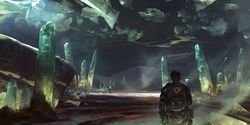
Beneath the surface of Daleem lies a complex and extensive interconnected tunnel system. While the geological origins of these tunnels — whether natural or artificial — remain unknown, past efforts to mine subterranean minerals have since widened the cavernous network. However, the unveiling of ancient ruins belonging to a multitude of long dead civilizations and rumours of ghost sightings, missing gear and failing machinery have since led to the abandonment of the Guilds’ mining efforts within the tunnels at the request of the Vatali Conclave. Derelict drilling rigs, mining equipment and still-lit lights are all that remains in an eerie reminder of the Guilds’ presence, who have taken to sealing off entrances deemed dangerous to those who might seek to salvage.
Recent efforts to uncover the tunnel network in an effort to better understand the mysterious ruins of a Force-based civilization have presented undeterred archaeologists with a variety of challenges. Hardened lava flows in the tunnels have partially closed off several tunnels and caverns, creating the need for additional drilling in the area. Moreover, the same siesmic activities that resulted in the changes on the surface have also occurred underground. Because of this, cave-ins are more frequent than before, and efforts to drill through the hardened rock need to take care not to drill into passages that have since flooded. Some of the lakes and rivers present on the surface now feed into these caverns, forming underground springs of fresh, sparkling water that reflect the subterranean crystals.

Measured to extend underneath shallow oceans, the tunnels are known to reach depths of 500 meters below the surface. However, none have ventured so far since the Guilds’ abandonment of the network. In diameter, the longest stretches tend to be between 50 and 60 meters — the average width of a drilling rig. These longer stretches are often featureless and best traversed with the assistance of a treadspeeder or other vessel capable of handling the rocky terrain. Larger caverns resembling natural caves or tooled ancient structures reside in groups that are accessible via shafts connecting one to the other. It is apparent that multiple civilizations over the eons have used the tunnel network as either a home or transportation means. The oldest ruins discovered have the strongest links to this network of tunnels and as such it has been speculated that this civilization created this great work of excavation, however for what purpose or means is unclear.
Ithorian Gardens

Originally designed as a means to test and determine the best candidates for species of flora that can thrive in Daleem’s new mineral-rich landscape, the Ithorian Gardens have since evolved into one of the largest reclamation sites on the surface of Daleem. Cultivated thanks to the efforts of the Indag-Conclave of Daleem, the Ithorian Gardens are home to the largest collection of flora species in the entire Vatali Empire. As its name suggests, the Ithorian Garden’s caretakers are primarily of the hammer-headed species from which the site borrows its name.
Encircled with young, blossoming forests as far as one can see into the horizon, the central focal point of the gardens lies within the center of the Indag-Conclave’s restorative project. Flowers of various origin are planted in rectangular fields stretching as far as the edge of the forest, arranged as a gradient of hues from green to exotic colours, like violet. Inserted among these geometric plots of land lie several greenhouses — buildings which exist to segregate new species for validation and potential integration into Daleem’s landscape, and also to conduct scientific tests using instruments that reside within these specialized laboratories.
According to the needs of the individual species of flora that reside in the gardens, a number of species of fauna are selected to reside in the gardens, from specific species of insects and worms to mammals. Given the risk of contamination from unwanted or invasive species that can be brought to Daleem via infested plants, however, a number of pesticides might be employed at the time of an outbreak.
A careful listener might take notice of the soft melodies its caregivers are known to sing with their twin mouths, believing such harmonies to promote the regeneration of Daleem’s flora. As attuned to Daleem as those who call Ithor home are to their ancestral homeland, the Ithorians who tend the gardens practice their traditional funerary practices among the fields and forests that are tended to. From where one is buried, “We Wither to Bloom can be found written on a plaque or tombstone. Sprouting from their graves and nurtured by the nutrients of their bodies, mushrooms are often present in clusters denoting the burial site. Others with a keen sight might catch a glimpse of Odan-Urr Force-sensitives using their talents to heal and nurture the flora throughout the gardens — sometimes, as a condition of their passing one of the trials to Knighthood.
Mining Site Aurek-7
With no name other than its designation, Mining Site Aurek-7 is an infamous blemish on Daleem’s surface. Controversial in being the first site excavated via Jal-Taleer United’s massive Continent-class crawler, it extends several hundred meters below the surface, with a diameter of 10 kilometers in either direction. Excavated around a monolithic, red-coloured crystalline structure that towers over the mining site, the crater that now forms Aurek-7 is littered with mining vehicles, drills, and mobile storage units.
Multi-tiered, the site has duracrete entrances that feed into passages at level of the mine, where a Quorahi workforce toils to deliver stockpiles of electrum, and other rare minerals to feed the Vatali Empire’s addiction for such resources. Because of the multicultural nature of its workforce, the mine’s workers take shifts that align to their species’ biological schedules, ensuring that it is operated at all times. At night, the reddish dirt of the crater is illuminated with the assistance of several rings of generator-powered lighting arrays. In order to ensure that standards of safety are met, and to deter sabotage due to a growing discomfort of Jal-Taleer United’s activities, guardsmen from the Vatali’s Royal Guard are posted along the perimeter and within the mine itself.
Colonies and Industry

While Daleem promises a future as a paradise for self-sufficient colonization, the current stage of its reclamation has not yet allowed for the reestablishment and building of its former cities. With the guilds’ focus on reclaiming the land for the future permanent settlement of Vatali citizens, its efforts in recolonizing have been limited to smaller-sized colonies of a Quorahi workforce seeking themselves to benefit from the haven that Daleem is determined to be.
Constructed from the minerals mined locally, the colonies themselves can best be described as collections of prefabricated structures which are able to be relocated to other sites in need of restoration, keeping with the Quorahi’s nomadic tendencies. Ranging from a few dozen, to more than several thousand inhabitants, these mobile colonies serve purposes ranging from mobile farms to remote mining crews. Additional amenities are given to these colonies, dependent on their tasks ranging from agricultural structures to resource extractors. It is these settlements that represent the backbone of the guilds’ efforts to restore Daleem into a hospitable paradise.
More permanent colonies, while rare, are often found closest to long-term efforts in development. Because of the richness of electrum crystals on Daleem’s surface, these permanent colonies match the stylistic choices of the Sephi in the system’s capital, being comprised of structures either trimmed in golden electrum plating or coated entirely in the precious material. Still consisting of mostly Quorahi inhabitants, skilled or knowledgeable Sephi might volunteer to take part in the earliest efforts to colonize the planet, while hand-chosen nobles are appointed to oversee some of the planetary and guild affairs.
Often situated near or within these permanent colonies lie the industrial centers and managerial offices of the guilds. Industrially-sized spaceports, factories and functional shipyards exist on the surface, due to the guilds’ preparedness in developing these structures in Daleem’s orbit. Once built, these structures were dropped into various locations from orbit, equipped and able to begin functioning at a moment’s notice.
In response to the storms plaguing the upper atmosphere, the Vatali have devised several large space elevator systems that can transport goods, people, and even ships through the storms unharmed due to an electromagnetic field and heavy shielding which helps to mitigate their impact. This allows for the importation and export of goods that cannot otherwise be transported to the surface. At the top of the space elevators in low synchronous orbit are medium-sized platforms to allow for the storage of goods before shipping them back to the main world of the empire. When one of the storms is happening over the main content the space elevators are the only way to get anything safely on or off Daleem. However, when the storms recede, the spaceports and the space elevators are both utilized to increase productivity.
Population and Culture

While recolonization of Daleem’s surface is at its earliest stages, its citizens are comprised of the labourers and workers that were sent or volunteered to assist in either the reclamation of the planet’s surface or the exploitation of its resources.
Workers of various fields and specialties, the earliest settlers of Daleem’s transformed surface are primarily of Quorahi origin, having sought employment with one of the local guilds to assist in building a new home for themselves. While a number of Sephi have also joined the cause, it is rare to see one of their number within the mobile colonies. Sticking to their nomadic heritage, the Quorahi locate themselves wherever their current tasks lie, not often lingering for too long at a single site. As spiritual people, the Quorahi are motivated by the promise of having a home to build; if not for them, for future generations.
While each settlement operates independently of one another, each takes its tasks from the guild to which they are employed; more often than not, building an identity off their chosen profession. At times, these colonies might interact or “make camp” with others — times in which it might be beneficial to combine their talents towards a specific goal. In these cases, there is some fluidity where a member of a mobile settlement can transfer to another, as it is generally acceptable to do so.
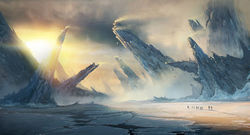
While the distinction between Quorahi and Sephi exist on Daleem (particularly where one resides,) all are imperial citizens of the Vatali Empire, and are thus answerable to the same laws and government as those remaining on the main planet of Kiast. The Quorahi themselves are made up of many different races and backgrounds, but identify more with the guild they are a part of than their own race, species, and sometimes even family.
The Guilds of Daleem
While all residents of the planet are direct citizens of the Vatali Empire, the vast number of trained specializations, natural resources, and corporate wealth lead to the creation of the Guilds. These conglomerates once operated with some measure of sovereign control over their assets; however, a history of secessionist activities within them have resulted in direct intervention from the Crown. While most of the guilds still retain their leadership, direct oversight of their affairs has been passed onto Commander Slynn Keldra, as the representative to the Empress. Barred from forming militias and having underwent disarmament, the Guilds now fall under the protection of the Vatali Royal Navy, whose task is to defend the Guilds from both threats and corruption.
While the defense and oversight of the guilds fall to the Vatali Royal Navy's commander, supply chains and the allocation of resources fall to Daleem's local Governor. Materials, land rights and funds are among those resources which are allocated to Guild projects. Given the scale of Daleem's restoration efforts and the need for materials to be sent to Kiast, however, there still exists a fair amount of competition between the Guilds to obtain these grants. This, of course, causes Guilds to utilize any means necessary to gain an edge over their competitors and to gain favor with the Governor.
Commander Slynn Keldra is tasked with the oversight and defense of Daleem.
Daleem’s Governor is a Sephi by the name of: Previt Golvrim
The Shipwright's Guild
Once the dominant guild of Daleem, the Shipwright’s Guild remains an important asset of the Vatali Empire in the manufacture of starships and airships, and the fabrication of components that comprise them. Comprised mostly of Sephi, Humans, and Mon Calamari, it also employs a number of Quorahi workforces. The fields of work involved include (but are not limited to) electricians, metal shapers and producers, engineers, construction, shipwrights, and chemists. With a member base 300,000 strong, the only joining criteria for the Guild is that the member agrees directly in the construction or preparation of materials for the building of ships.
It is perhaps due to this guild’s experience with objects able to withstand entry into the atmosphere that the Shipwright's Guild was able to create the prefabricated structures that now comprise Daleem’s many facilities following the cataclysmic event that would have destroyed facilities on the surface. This has created a new market, in which the Shipwright’s Guild is able to deliver new structures across the surface of Daleem at a moment’s notice. This has proven to be immeasurably useful, both as a means to establish new mobile colonies and facilities and as a reason for the guild to establish an orbital shipyard and prefab construction site. The Shipwright’s Guild outright owns several factories and facilities in which their members work, while the structures of other guilds across Daleem are either sold or leased.
With the events of the Shadow of the Kesaret, and the revolt of the final Guild Master, Glav Valenforge, the Shipwright's Guild has come under Imperial immediacy. Empress Kaltani has placed the guild under crown control, allowing day-to-day operations to default to a succession of Governor-Generals sitting on the guild's board of directors. It is expected that heads of the noble families will be given seats as the new board of directors gets constituted.
The Guild’s current leader is: de jure Empress Kaltani.
Pau'an Pharma and Chem
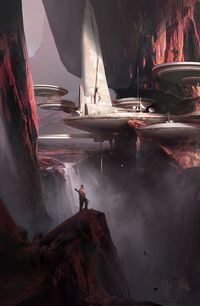
Previously a small guild with an unusual amount of influence, Pau’an Pharma and Chem has grown in both favour and importance given the need for research in the reclamation of Daleem. Comprised of 30,000 Pau’an scientists, all members of the Guild also form the entirety of a pharmaceutical and chemical research company of the same name. Due to their upstanding medical products and research into beneficial chemical compounds, the Guild has proven invaluable in researching the soils and unearthed minerals of Daleem’s surface. Not much else is known about Pau’an Pharma and Chem as they maintain a veil of corporate secrecy on all things including the protest of, yet still allowing, governmental inspections of their facilities.
While Pau’an Pharma and Chem employs few Quorahi task forces of its own, it is the main supplier of vaccines, medicines and chemical goods (such as pesticides) to both the mobile and permanent colonies across Daleem. With the sudden interest in the ruins within the tunnels, Pau’an Pharma and Chem has turned to including several archaeologists among their number. Geological studies are another focus of its efforts, monitoring seismic activities and conducting regular tests on Daleem’s remaining terraforming devices.
Through royal decree, Pau’an Pharma and Chem has been tasked with ensuring the creation of redundancies and fail-safes that would prevent another disaster that might occur. Since its re-establishment, its facilities have concocted an entire network of both orbital and ground-based devices designed to monitor and stabilize the planet’s crust and mantle from further changes — smaller, more plentiful, and much more guarded than their predecessors. Sensors placed on the surface both monitor seismic activity and ionization of the atmosphere, providing constant data that is used to mitigate the ill effects of Daleem’s electrical storms through giving adequate warning.
The Guild’s current leader is a Pau’an by the name of: Kintril Kastriv
The Guild's capital location: Sajin
The Indag-Conclave of Daleem
The dominant guild of Daleem, the Indag-Conclave now boasts one of the largest memberships of the planetary guilds — a stark contrast against once having the smallest memberships among the guilds. Comprised mostly of Ithorians, Humans and known to have a few Sephi in major leadership positions, its numbers have inflated to an estimated 15,000,000 due to the sheer amount of mobile Quorahi task forces it now employs to reclaim the land.
When the Ithorians first arrived they were able to aptly study the land and expertly cultivate much of Daleem by erecting specialised bio-domes and push much of the farmable land far beyond what the other locals had thought possible. At first, the Ithorians were asked to remain on Daleem as Imperial Citizens on the condition that they continued to cultivate the land for all the other citizens. However, at the time the Ithorians leaders were savvy and realised how much value they were to the planet, so they issued their own request: they would stay on the planet as citizens if and only if they were given a form of ‘grant’ to allow them to focus on scientific study whilst on the planet, despite being Ithorian, they didn’t live up to the stereotype of holding a love of agriculture and philosophy exclusively, instead they were avid scientists and engineers who longed to further their own personal study. The Sephi agreed to their terms, allowing the Ithorians to independently run their own research on the planet.
Now, the Indag-Conclave is the leading guild in the restoration of Daleem’s agriculture and native life. It is responsible for locating and integrating flora and fauna that will comprise a functional ecosystem, as well as tending to the planting of gardens and forests. With the assistance of the Quorahi’s nomadic settlements under its arm, the Indag-Conclave is a planet-wide entity in a constant state of growth.
The Indag-Conclave of Daleem was founded to allow the Ithorians to conduct their research in a professional manner whilst also managing their allocated funds. The Conclave itself works both ways, allowing Sephi leaders to sit and observe the Ithorian research - sending any potentially valuable research to the Empire for further analysis. The Conclave is made up of 4 individuals, two Ithorians, usually also their racial leaders, and two Sephi with one Sephi being given more control than any of the other 3 sitting Leaders.
The current Conclave leaders are: Illor Bata, Momurr (Ithorians), Aeryn Osstar, and Drych Stalwon (Sephi)
The Conclave's capital location: Zadan
Jal-Taleer United
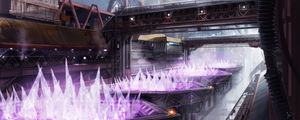
Jal-Taleer United (also known as the Daleem Mining Guild) is the second-most prominent guild on Daleem, while also being the first guild formed since its transformation. Its rise stems from opportunity, in the wake of the planet’s raw minerals being lifted from the upper mantle. In concentrating its efforts on mining the crystalline structures for resources, Jal-Taleer United is the primary supplier of raw materials throughout the system — including the abundant but sought-after electrum crystals used for the metallic gold plating valued throughout the Vatali Empire. It, unlike Daleem’s other guilds, is the sole guild that is first and foremost Quorahi-founded in tandem with one Sephi noble by the name of Zaethi Toldreyn.
Controversial, as its mining efforts often make use of a Continent-class crawlers under its ownership that is capable of peeling mantles and strip-mining resources, Jal-Taleer United is under strict observation at all times in its activities. There have been several petitions by the Indag-Conclave of Daleem to ban the use of these devices, but the guild has so far managed to adhere to the strict regulation imposed on its use of the crawler.
Under Jal-Taleer United’s employ, a Quorahi workforce numbering an estimated 6,000,000 have set to mining in remote areas all around the planet. However, given that the rarest of the resources still lie within the tunnels, Jal-Taleer United has also begun unearthing the sealed entrances — and with them, whatever hides inside.
The Guild’s current leaders are: Jaleer Tao-ni (Melitto) and Zaethi Toldreyn (Sephi)
The Guild's capital location: Quath